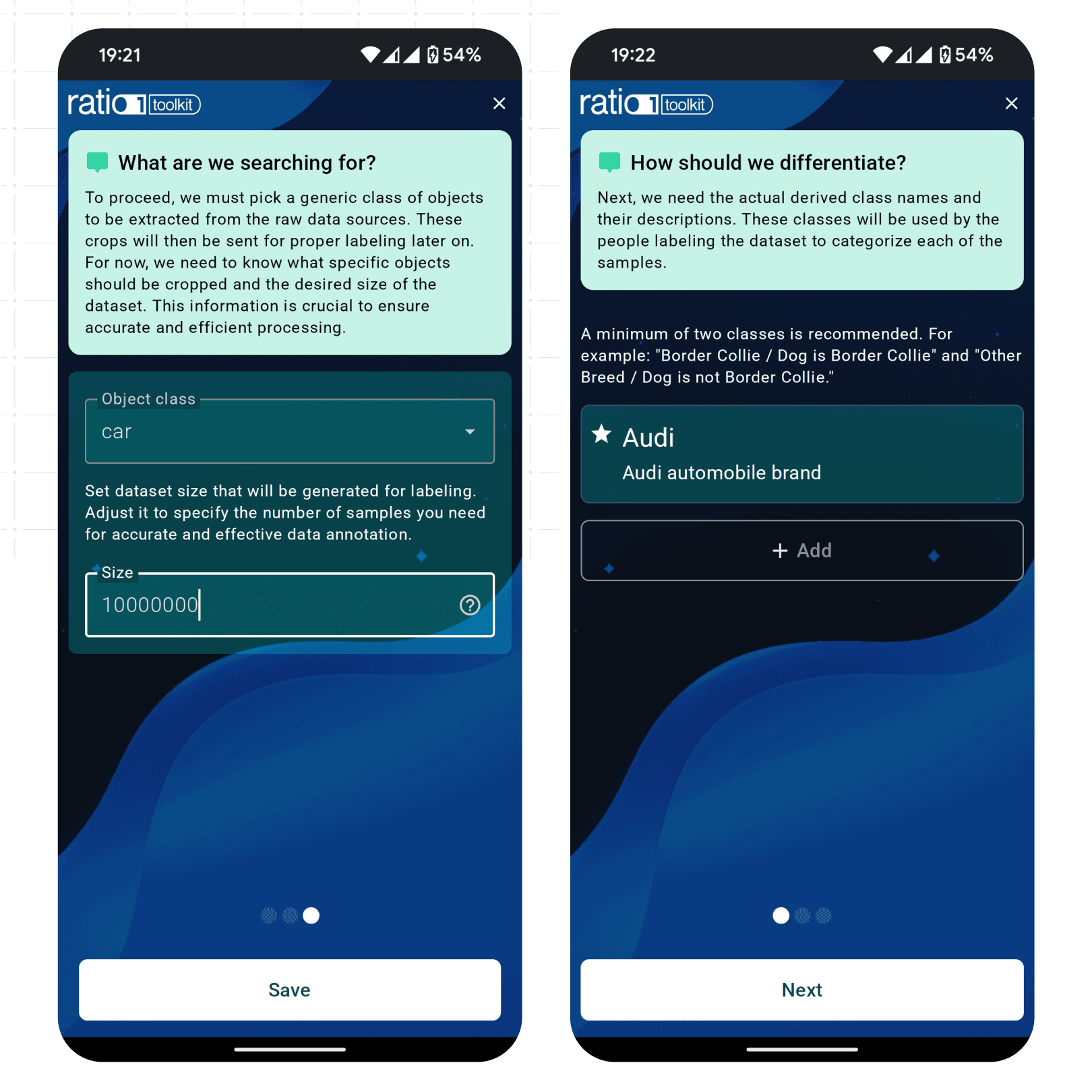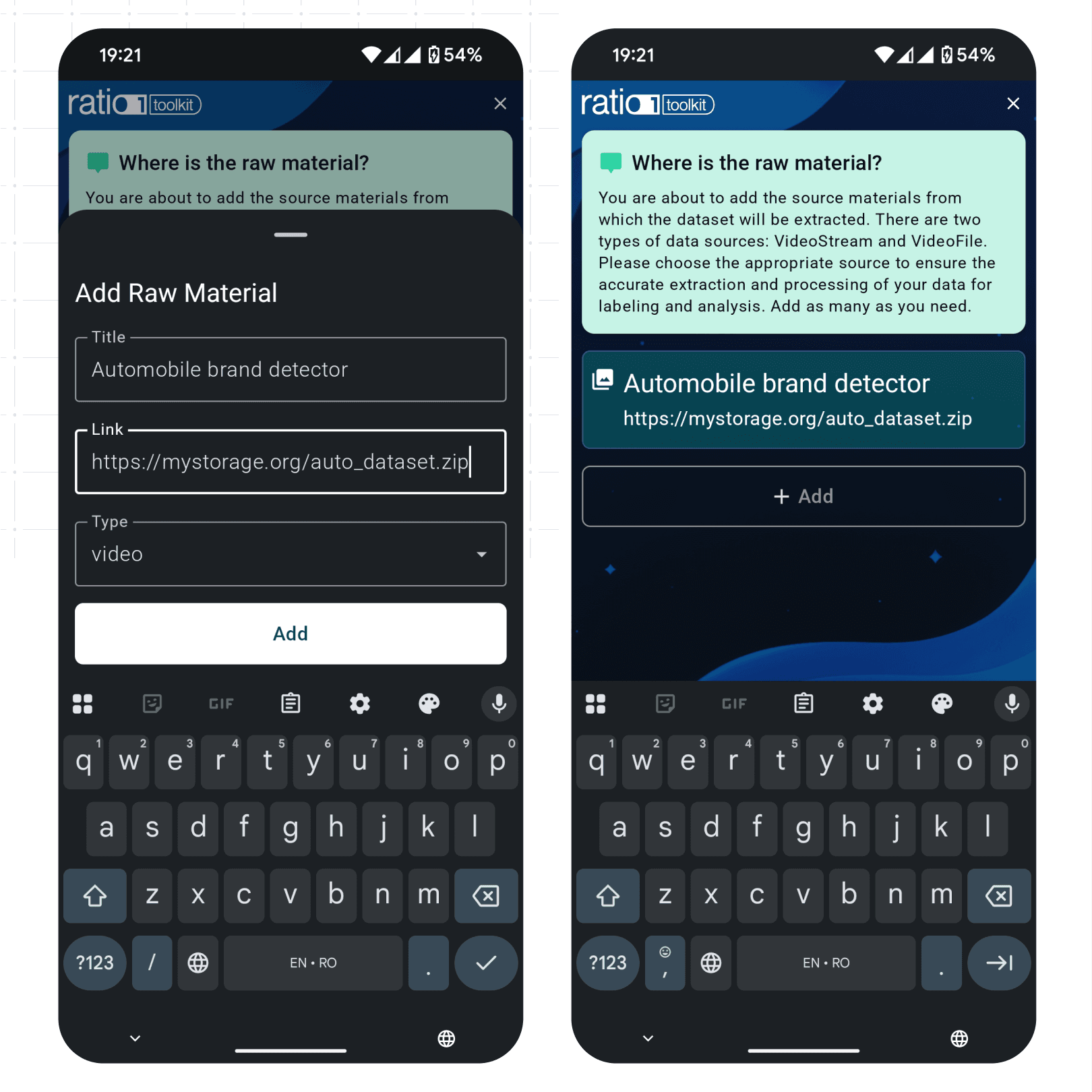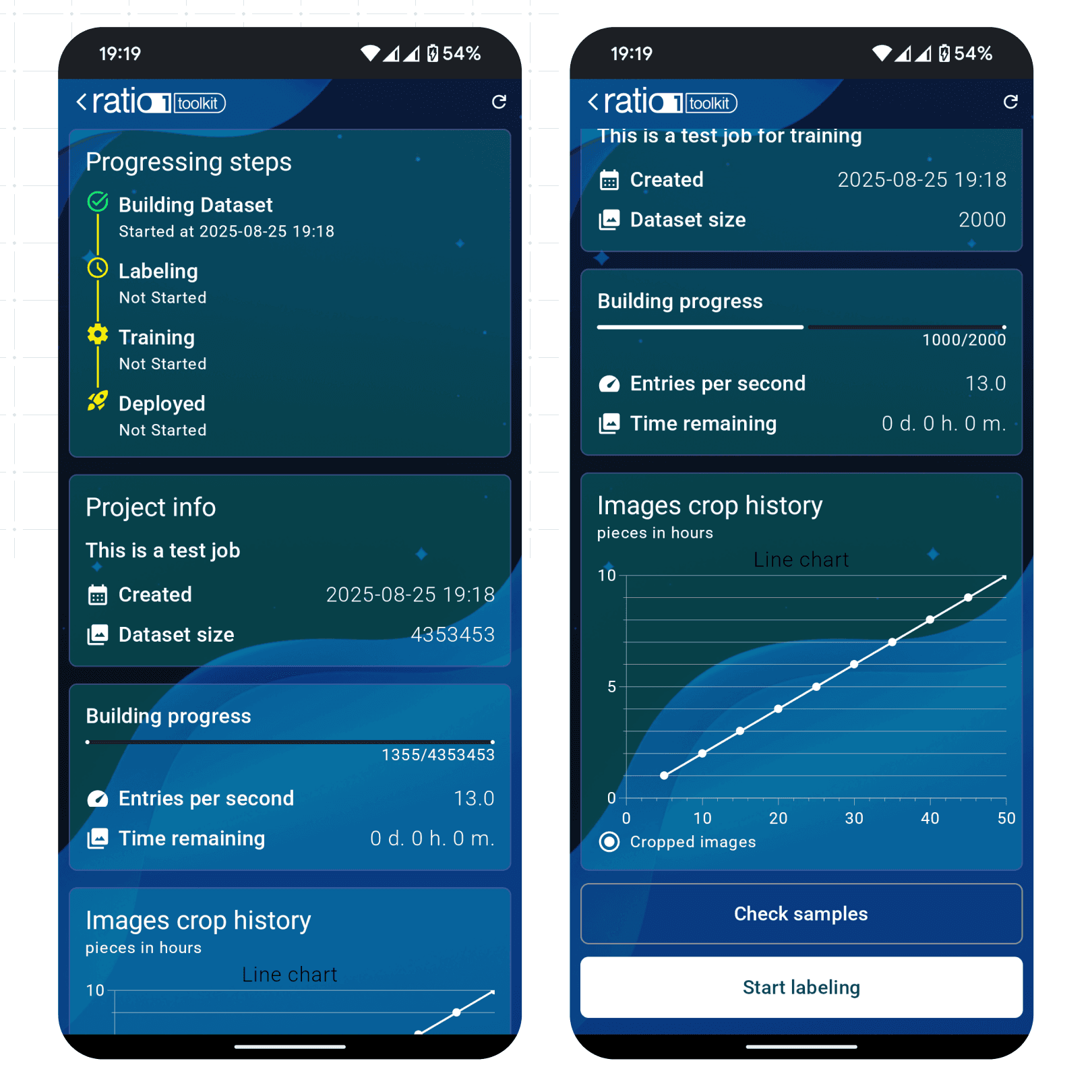Ratio1 AI‑4‑Everyone (AI4E) Framework: Technical Preview
For Developers
Education
Ratio1’s AI‑4‑Everyone (AI4E) initiative aims to let anyone build custom AI apps on mobile devices through a guided workflow. It consists of two companion apps: the AI4E Creation Toolkit (a wizard-driven mobile app creator) and AI4E LabelCraft (a crowdsourced data-labeling app). The Creation Toolkit guides the user through each step of an ML pipeline - from defining the app and data to deploying a trained model and “attaching” that model serving backed to a pre-defined user interface from a given set of templates - while LabelCraft engages volunteers to annotate data for training. Crucially, both tools leverage blockchain-based smart contracts: when a user launches a project, on-chain transactions automatically fund the labeling and training processes. This makes the pipeline transparent and self‑contained, with rewards paid out in R1 tokens while the funds are temporally stored throughout the job lifecycle in stablecoin in order to protect all participants to any volatility related risks. (In fact, our roadmap explicitly calls the Creation Toolkit a “low-code toolkit [that] helps users build AI applications” and LabelCraft an “AI4E data-labeling tool”.)
This article presents the pre-beta versions of the AI4E Creation Toolkit (R1-5) and LabelCraft (R1-158).
AI4E Creation Toolkit
The AI4E Creation Toolkit is a mobile app (Android/iOS) that functions like a wizard or guided assistant for building computer-vision applications. In a sequence of simple screens, the user specifies the AI use case and data, and the Toolkit handles the rest. For example, the steps might include:
Select an application type: The user chooses what kind of computer-vision app to build (e.g. image classifier, object detector, OCR reader). The toolkit may offer single-stage vs. multi-stage pipelines (single-stage might be a one-shot model like YOLO that might need specific training for a particular set of target object detection classes, while multi-stage could mean detect-then-classify, etc.).
Select what data should be extracted and how it should be used. The user is guided to explain exactly what the models are looking for (i.e. must detect a particular object in an image or must identify if a log line looks suspicious). This will be further used in the following two data prep steps.

Provide or specify data sources: The user links the dataset that the model will train on (e.g. upload images from device, connect a cloud photo album, or link to a public dataset URL)

Launch labeling workflow: If needed, the Toolkit automatically kicks off a labeling campaign by sending the raw data to the LabelCraft community (see next section).

Monitor model training: Once labels are collected, the Toolkit starts model training (on-device or in the cloud) and shows real-time progress/status to the user.
Configure model serving: After training, the Toolkit provisions a backend to serve the model. It might spin up a container or cloud function to host the model for inference.
Attach a user interface: Finally, the trained model is connected to a simple front-end. The Toolkit provides a predefined UI template (for example, a mobile app screen or web demo) and wires it up to the new model so the user has an end-to-end working app with minimal coding.
Each bullet above is guided by the app’s wizard UI, with clear prompts and presets. The user never has to write code: instead the Toolkit invokes underlying ML tools and infrastructure. Under the hood, it uses established libraries (PyTorch being the default but Tensorflow is also possible) to train as well as serve (via our Torchscript based serving backend). For large jobs, training may occur based on a decentralized setting using Ratio1 decentralized federated learning EDIL framework that also includes homomorphic encryption approaches (via pre-trained or few-shot trained autoencoders used for embedding generation). In such a scheme, raw data stays on users’ devices, enhancing privacy, while model updates are shared and merged (and contributors are rewarded).
Throughout this process, the Creation Toolkit remains user-friendly and low-code. The Ratio1 roadmap explicitly describes it as a “low-code toolkit” to help anyone build AI apps. The app’s interface would show progress bars and simple forms instead of code. For example, when it “sets up the backend,” the user might just tap a button saying “Deploy”, while the system configures a server or container behind the scenes. All technical complexity (data pipelines, model selection, hyperparameters, container orchestration) is managed automatically. In short, the AI4E Creation Toolkit wraps the entire ML lifecycle - data collection, annotation, training, and deployment - into a step-by-step mobile wizard.
AI4E LabelCraft
The AI4E LabelCraft app is the crowdsourcing engine that powers the Creation Toolkit’s training data needs. It is a mobile app that any volunteer can install to help label data in exchange for rewards. LabelCraft provides a list of available annotation jobs (for example, “draw bounding boxes around cars in these images” or “label the following videos with activity tags”). The interface is gamified: it makes labeling easy and rewarding, much like a game or quiz. For each task, LabelCraft might show simple tools (tap to tag, draw a box, select a category) and submit results in one tap.

Importantly, LabelCraft incentivizes users with rewards. This follows emerging trends in decentralized AI - turns data labeling into a game where users “monetize their spare time” by completing tasks without requiring technical expertise. To ensure quality, the system can require multiple users to label the same item or use algorithmic checks.
In summary, LabelCraft turns data annotation into a community activity: anyone can contribute to training datasets through a user-friendly mobile interface and earn crypto for it. The collected labels automatically feed back into the Creation Toolkit’s pipeline, supplying the “ground truth” needed to train the user’s custom model.
Blockchain-Powered Incentives and Workflow
A defining feature of AI4E is on-chain orchestration. When a creator begins an AI project in the Creation Toolkit, the app creates or interacts with a smart contract on the Ratio1 blockchain. The user deposits tokens into this contract to fund the upcoming labeling and training / serving tasks. Smart contracts then automate payments to LabelCraft annotators and to compute providers as milestones are reached. For example: once enough labels are gathered and verified, the contract releases payment to those labelers; once the model finishes training with acceptable accuracy, the contract releases payment to the node that performed the training or returns remaining funds to the project owner. This approach ensures transparency and trustlessness: everyone can verify on-chain how many tasks were issued and paid for.
Key aspects of this blockchain integration include:
On-Chain Funding: Project creators allocate tokens via a smart contract to pay for labeling and training. This contract governs the workflow (for example, “once 10,000 labels are submitted, pay out $X to labelers; once model accuracy ≥ Y%, pay out $Z to the trainer”).
Automated Rewards: LabelCraft annotators automatically receive tokens for each completed task. For example, when a label is verified as correct, the smart contract credits the user’s redeemable amount.
Transparent Tracking: Every labeling and training task is logged on the blockchain. Creators can inspect the ledger to see which tasks were done and ensure fair payment.
Secure Model Deployment: Once training is done, the model is deployed. The smart contract can signal to a hosting platform (possibly a decentralized server network) to serve the model for inference. The frontend UI (attached by the Toolkit) then connects to this backend. In some designs, even model downloads or updates could be managed by on-chain cues.
In essence, AI4E’s blockchain layer removes middlemen and automates billing. The user of the Creation Toolkit doesn’t manually handle invoices or invoices; instead, they use crypto transactions to pay for the crowdsourced work. This aligns with other “AI for Everyone” visions where democratizing AI goes hand in hand with decentralized finance models.
Conclusion
In summary, the AI4E Creation Toolkit and LabelCraft form a complete pipeline for non-experts to launch custom AI solutions. The wizard guides users from app concept to a working model, while the LabelCraft community and on-chain contracts handle data labeling and model training. This community-driven, blockchain-funded approach is designed to make AI development broadly accessible - truly putting AI “for everyone”.
Andrei Ionut Damian
Sep 2, 2025


